
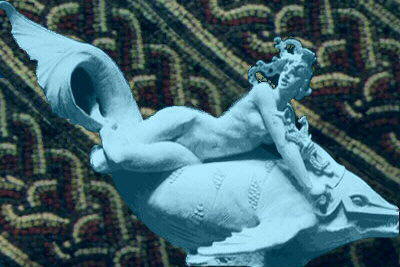




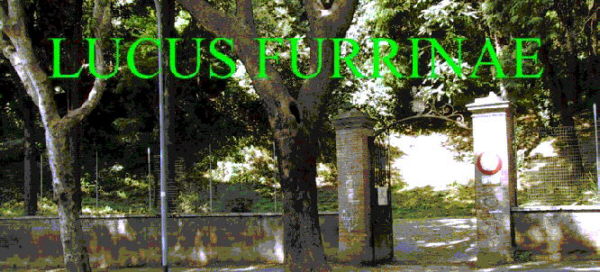
| The small grove of Villa Sciarra, corresponding to the entrance of the Via Dandolo, dates from time immemorial. It seems that in remote Antiquity this area was densely forested, with steep escarpments; its spring regarded as the dwelling-place of the Goddess Furrina, an entity not entirely benevolent in nature. The strange coincidence could cause doubts to arise that it was indeed the Goddess who safeguarded the age-old sacred grove. |
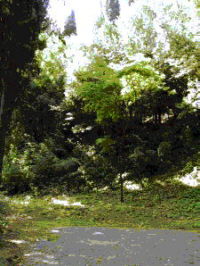
Grove of the Goddess Furrina
| The present-day forest is much less wild, yet presents a disquieting aspect in the marginal place occupied by the Villa. |
| The exact origin of the cult of the nymph Furrina is not accurately known, despite the existing mention of a Flamen Furrinalis, whose institution is attributed to King Numa. However, according to a statement by Varro admitting the impossibility of knowing more, this (Flaminate) was an honor taken from the Ancients, who also had instituted an annual sacrifice directed by a Flamen, although we no longer know anything more than its name. |
| Furrina was identified, from time to time, with the Erinyies (Furies); with an infernal deity; a divinity related to the water of the well-spring or with a divinity of Etruscan origin. In relation to the Goddess, we found a depiction of the Furrina nymph on a lamp of the Augustan Era (prior to the year 743 AUC), represented with the numeral three; with a jar, typical of an entity bound to the water; and with a torch, typical of the Furies. This is another indication that bring us to the conclusion that She is not necessarily a benevolent being. In effect, this impression is confirmed by the positioning of the cult in an uninhabited, uncultivated spot such as a sacred grove beyond the Tiber (Trastevere), where the Romans were accustomed to relegating that which was seen as abnormal in one sense or another. It was no accident that Gaius Gracchus met his end in the Lucus Furrinae. |
| It can be stated that the cult of Furrina was important, as it is proven that the Furrinalia continued to be observed beyond the year 950 AUC, with a Flamen dedicated to the service of the Nymph; with perhaps a sacred edifice as well in the interior of the Lucus; and a celebration of the Sacred Springtime, that had to have been observed by many of the faithful. |
| The goddess Furrina seems a resonance in polytheist key of the spirit of an animistic religion; bound to the place, the forest, to the underground spring located there. In addition, the epigraphic material of the Republican Era found in the zone, referring to the divinity Febris, can confirm the hypothesis of even a therapeutic use of those waters. |
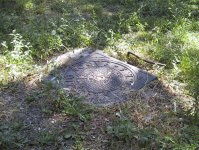
Site of the Spring
| The most ancient relic of the zone, in effect, has been used ceremonially as a pool. The first excavations were the work of Glaucker, in 1908, and were undertaken after the discovery of the small villa during excavations undertaken by the penultimate owner, North American diplomat G. Wurts. Precisely owing to these excavations, the water flow that fed the orchards and the valley was interrupted and Glaucker was able to locate both the flowing spring of Furrina, the Syrian temple, and the layout of subterranean channels. |
| The recently-discovered spring of the goddess Furrina consists of a well of eleven meters depth, at the heart of which have been excavated four galleries of almost three meters height, oriented to the cardinal points, for collecting the water. Another gallery has been found in this cavity, corresponding to the galleries towards the west which have continued to feed the spring. The evidence that this cavity has resulted from erosion demonstrates the fact that it is much more ample than those encountered by Glaucker. |
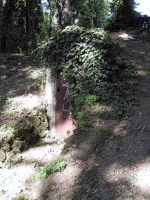
The water distribution tower
| According to Glaucker, the water of Furrina's spring was traversed by a channel that nourished a nymph dwelling in the environs of the present-day Via Dandolo, where eventually, in modern times, the water collects in cisterns. Even today in the vicinity of the Villa's entrance, a water distribution tower exists to channel water to the gardens and adjacent streets. |
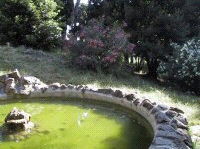
Probable site of the collection chamber
| In the Syrian temple's spring, only one collection chamber has been recently found. Numerous conduits emanate from it, one of them joining with the conduit of Furrina's spring. |
| On the opposite side from the temple exists an earthen slope, formed almost surely by a collapse of the ground many years ago, revealing a conduit formed by four branches. It is not known whether it is ancient or modern. Amid the loosened soil, numerous tiny fragments of amphoras and roofing tiles are easily found. |
| During this research, as mentioned earlier, the desired results were not obtained thus to shed light upon the nymph Furrina. By the time of Terentius Varro, almost nothing was known of the Nymph as attested by this phrase: "Quoius deae honos apud antiquos. Nam et ei sacra instituta annua et flamen attributus: nunc vix nomen notum paucis." |
| The connection with the Furies is that noted by Cicero (De Natura Deorum, cit.: "Eumenides... quae si deae sunt, quarum et Athenis fanum est et apud nos, ut ego interpretor, lucus Furinae, Furiae deae sunt..."), Plutarch. and Martianus Capella, where Fura Furinaque et mater Mania are enumerated as divinities of the subterranean world. |
| There existed a sanctuary not far from Arpinum, (Cicero ad Q.F. cit.: ab eo ponticulo qui est ad Furinae, Satricum versus), where Satricum is not the most well-known city of Latium, but another one in the territory of the Volscians. |
|
The inscription mentioned by Glaucker is as it follows: Dii` Keraunivw/jArtemiV hJ kai` Sidwniva Kupriva ejx ejpitagh'V ajnevqhken kai` nunfe`V (sic) ForrivneV (sic). This one inscription corresponds to the year 800 AUC, demonstrating that although the ancient cult of the nymph Furrina had not been absolutely forgotten, another one was imposed with force under the aegis of Jupitor Ammon: "Iovi optimo maximo Heliopolitano Augusto, genio Forinarum et cultoribus huus loci." Pertaining to the Antonine and Severan period, it is precisely in this epoch that the cult of Jupiter Heliopolitanus became established. |
| * VIII. KAL. AVG. = 25 of July : FVRRINALIA |
| C IVLIVS BARCINVS CICONIVS: FLAMEN FVRINALIS |
| MMDCCLVI a.u.c. |
|
|